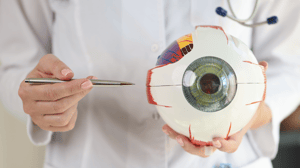Researchers at the Karolinska Institutet in Stockholm have tested a microscopic device containing cells from the pancreas, designed to be inserted between the cornea and the iris (where the immune system does not reach, and therefore cannot reject it).
There is a truly unique place inside the human body: the anterior chamber of the eye, the tiny space located between the cornea (the very thin transparent layer that covers the iris) and the iris itself. There are no blood vessels in this space (if there were, the cornea would no longer be transparent); instead, it is filled with aqueous humour, through which nutrition is provided. Given that there is no blood supply, the immune system does not reach this area, meaning there can be no rejection reactions here. This “chamber” is easy to access, surgically speaking, without the need for invasive methods, and it is, as we have said, completely transparent, making it possible to check on the implant's operation via simple visual monitoring.
It is for these reasons that the researchers at the Royal Institute of Technology and the Karolinska Institutet in Stockholm, Sweden, chose it as an ideal location to implant a microscopic device containing pancreatic beta cells (the cells capable of producing insulin), to treat all types of diabetes when the naturally occurring cells of this type in the pancreas have ceased to function.
A 3D-printed “bio-hybrid” device
As explained in the scientific journal Advanced Materials, it is a “bio-hybrid” device, 3D printed using a resin designed to be compatible with the eye, 240 micrometres (thousands of a millimetre) in size and wedge-shaped. It contains the beta cells, a power supply chip and a system for manual fixation, without the need for stitches, at the angle between the iris and the cornea. During tests conducted on lab animals, the device remained stable in its position for over 20 weeks and was quickly integrated with nearby tissues, beginning to function and to secrete insulin (which wound up in surrounding blood vessels and from there entered the bloodstream).
Preparing for human trials
New studies are ongoing, in order to reach a stage when the device can be trialled in human eyes. What's more, in addition to treating diabetes, the researchers are examining the possibility of using this technology for other kinds of therapies, when it is necessary to provide the body with other specific types of cells, which are lacking or not functioning as they should. The benefits seem clear: the system is non-invasive, it does not carry a risk of rejection and, as was mentioned above, allows for verification of the implant's stability and operation over time through simple visual monitoring. Additional research is, however, still needed.




